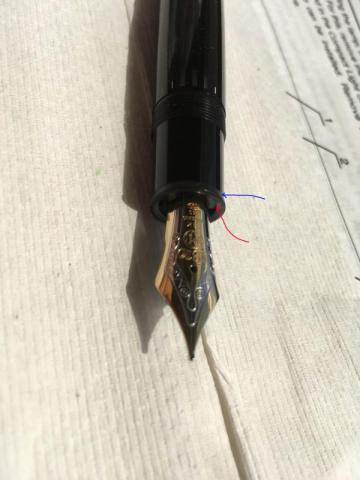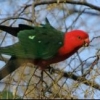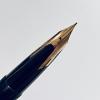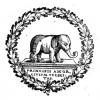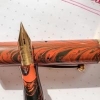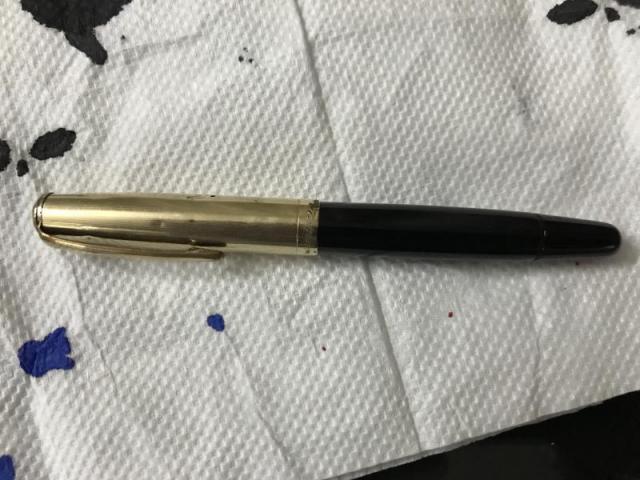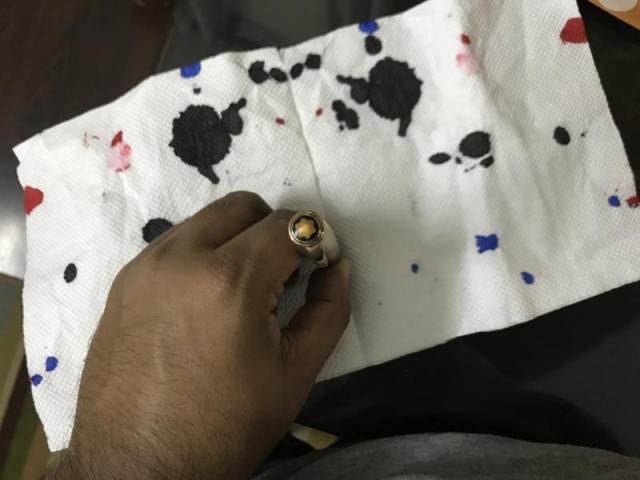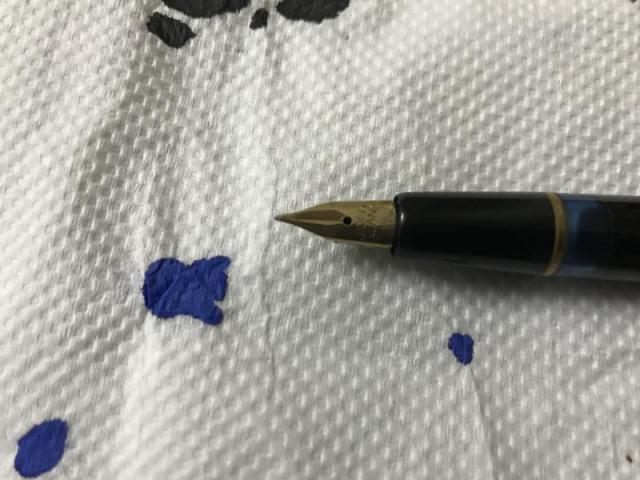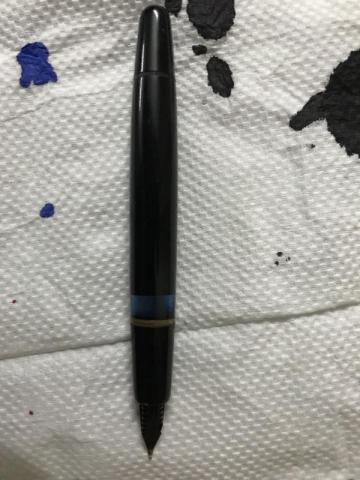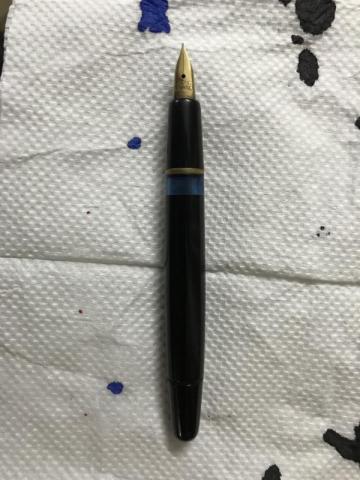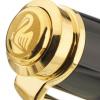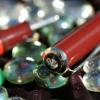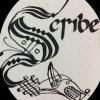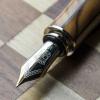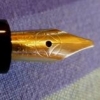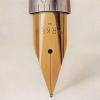Search the Community
Showing results for tags 'piston'.
-
Hi, I have a vintage m400 whose piston is broken. The casing of the piston is in 2 pieces. How can I fix this? Can I buy a new piston casing? Thanks!
-
Hi everyone, I am new to the fountain pen network but have already used the large knowledge base here to guide my recent purchase of a used Montblanc 149 from the 90s. I'm very grateful for the the useful information here. Unfortunately, I may not have read quite enough. The pen arrived yesterday from an antiques store in Spain (I'm in NYC). It came with a little ink inside so I used the pen and found it writes wonderfully. However, while flushing the pen for the first time, I noticed there is a considerable amount of ink on the screws of the piston as you can see in the picture I included (that is supposed to be a shiny brass screw!). Also, I noticed that after a day of flushing, it is still not coming out clear, although it is significantly improving. More importantly, I tried to dry it by surrounding the nib with lint free wipes, and it seems like it could be leaking from either the red arrow, or blue arrow region in the picture of the nib, although I am not sure of this. Is this where a leak would/could form? It seems like there is ink everywhere inside. Most importantly, can this be fixed? If I took it apart, and cleaned and greased the different parts, would this fix whatever is wrong? If not, I'll be trying to return this.
-
I have a recently arrived Soennecken which will allow only very short piston travel, about the length of the ink window or less. Taking it apart, the piston mechanism uses a key on the piston running in a recessed keyway inside the barrel. Examining inside the barrel, I could see that the plastic is slightly fractured on the clockwise (from the back) edge of the keyway. What happens is that the piston draws up then the key enters the fractured section to the side, under torque from the piston knob, and jams there having no further straight path up. A bit like a train accidentally diverting to a siding with no exit route. The first obvious possibility is to rebuild the fractured section, perhaps with an epoxy. The difficulty will be to keep the barrel concentric and to shape the edge sharply. Fiddling around a couple of centimetres down an 8.5 mm barrel, I am not confident of that being a great success, if there is a better resort. Has anyone experience of this type of repair? What worked? I could ask the vendor for money back on the pen sold as already restored (they replaced the cork seal). I prefer to make things work if I can.
-
- keyway
- soennecken
-
(and 1 more)
Tagged with:
-
Kaweco Dia 803/07 Mini Review [Transcript from handwritten review below] I bought this pen on German ebay about a month ago. I always wanted to have a vintage Kaweco but after getting a piston-filler V11 I wasn’t very impressed (the nib was problematic but even if it has been fine, it wouldn’t have been what I was looking for). I stumbled upon this Dia not knowing much about it, but it wasn’t that big of a risk so I told myself ‘Why not?’ The pen came in its original box with a sale receipt dating back to 1958 (!) The pen turned out to be much smaller than I expected but I have small hands and do like smaller/thinner pens in general. Posted, it is perfectly usable. The 803 is a piston-filler and luckily mine didn’t need repairing: It operates quite smoothly for a pen of this age (that hasn’t been restored from what I gathered on the listing description). This is the first pen I have that has a blind cap, which I think is pretty cool. The barrel and cap are made of a plastic-like material that I guess is celluloid. It feels really nice to the touch and I think is a tad heavier than normal plastic. The cap has quite a lot in common with the modern Dia II. The clip on mine is very, very stiff, almost to the point of being unusable but I think it’s only a problem with my specific pen. The nib is very small compared to modern pens I have but not very out of proportion considering the size of this pen. Mine is a 14K nib that says Warranted above the little Kaweco stamp. As it came to me unrestored, the nib is quite scratchy (I think due to a slight bend and misalignment that I need to inspect as soon as I get a loupe and some proper tools). However, it lays down a very charismatic line known to pens from the 50s and 60s that I’ve seen and admired from reading reviews. Part of that charisma is due to the softness and the oblique cut. My only complaint is the section is too short for comfortable writing. That said, there is no large step down between the barrel and section so I can rest my fingers on the threads just fine. Overall, I am very happy with the Dia 803/07 though the nib definitely needs some work. It is a small but fantastic pen that I feel is somewhat underappreciated and often overlooked when it comes to vintage pens. [This is my first review on the forum. Sorry about the image quality ]
-
I'm studying a pen with a strange piston like filling system or kind of vacumatic system (the tube and the limited distance of the stem). The nib is Paris pen. The style is italian, but i doubt that. the bottom of the feed has a marking E The pistons working seem unclear to me and I didn't find an explanation in Marshall & Oldfield. the pictures are bad (iphone), but I'm a bit too intrigued to wait long. I will file better later. Anybody any idea about the system and make?
-
Hi all. I have a question: I think I understand what a clutchless piston filler is. The piston is operated by a threaded helix. You turn it to push the piston up or down, or keep turning the same helix beyond its stop point to disassemble the piston/pen. What is a clutch on a piston filler? I haven't been able to find information. I am asking also because I have a piston filler that I intend to disassemble and it does something that makes me think it might be a clutch type, but I would like to know what that is first. Best regards
-
Hi to all! I am writing on a new chapter about fountain pens. The particular topic is about the technical side of the ink reservoir. For most styles I have found all the information I need but not for the piston and bladder converter. The dimensions I would need are their volumes, the height/length to which they fill up and the mechanical length of the volume, which would be a smidgen longer. Sure, I could buy one each. However, so far, I have always received your help, otherwise, adding it all up, it would have been quite costly.
-
Hi all, This is my first post - it's so great to finally make an account after lurking for so long! I bought my third beginner fountain pen recently, a clear TWSBI Eco-T, which I have been lusting after for a long time, and finally arrived yesterday! I've already used one ink fill, and was screwing the barrel down to the refill it, and now it won't screw back up. the piston is at the bottom of the pen, near the nib, however there is no gap at the top of the pen where you should insert the wrench to unscrew the top. When I turn the top one way, it tried to press the piston further down into the pen (and it can't move any farther) and when I twist it the other way, it simply tightens the end cap! I've tried taking out the nib and using a thin crochet hook to push the piston up from the nib end of the pen, but it isn't moving and I don't want to force it. Attached is a picture of the pen body, nib attached but cap off. Any advice would be helpful, I'm new to piston pens and don't want to damage it! Thank you for your time! Eva.
- 10 replies
-
Hello All, I was looking on eBay and saw this Pelikanesque pen that is inexpensive and could be a good buy. Does anyone know who makes it? https://www.ebay.com/itm/NOS-PISTON-FILLER-FOUNTAIN-PEN-ORANGE-BLACK-M-NIB-MADE-IN-GERMANY-/142502157724
-
Hello, I am looking for advice on repairing the broken psiton rod that came with this Monte Rosa. I am not sure I will be able to find a replacement and the rubber seal appears to in very good shape still. It is broken and has chucks missing in the upper section so if I twist the piston all the way down it disconects from the threads and gets stuck in the barrel. Is there an optimal way to glue this or something? Your help is much appreciated
- 3 replies
-
- mont blanc
- monte rosa
-
(and 2 more)
Tagged with:
-
This is an unused L&C Hardtmuth Airless fountain pen I purchased recently (7000 lire in the 1950s, it seems, and over-priced today). The piston seal looks intact but is very stiff so I would like to grease it, whereon I discovered some interesting things on which I would like some advice. Pretty as it is, the pen itself has all indications of being something made for Hardtmuth by someone else, so in looking at further description and pictures, you may be able to relate it to something else German or East European, probably from the mid-1950s or a little earlier. Close examination of the section through the semi-transparent barrel suggests that it is not threaded. However, heat and force to the limit I was prepared to take the thin celluloid showed no sign of give. I think it is glued. I can chase removing the nib-feed assembly (it did not give easily) or try removing the piston. Before doing so, here are the curiosities (to me) and queries. The next two pictures show the piston knob under the blind cap (all pictures expand with suitable clicks): From the second picture it appears that the knurled knob is not formed with the threaded part, yet when you turn the piston knob then the threaded part unscrews from the barrel as the piston extends. It is possible to work the piston fully (and very stiffly) by this means but it can hardly (to me) be intended operation because the celluloid into which it is threaded will surely soon wear and crack. There is no flat or hole visible in the threaded or knob part, so if the inner knob is to release then it is simply a padded grip on the thread that would be needed while the knob is turned (after heating). I am expecting that the assembly is released by fully withdrawing the plunger using the inner knob (assuming it can be moved) then keeping it still while unscrewing the threaded portion from the barrel. By the way, knurling on the barrel is for effect only. Close loupe examination shows no join there. Is anyone familiar with this piston mechanism, or seen the same in a better known pen? Do you think I should simply resort to trying to unscrew the nib and feed, returning to the piston assembly only as a last resort? Thanking you for any assistance you may be able to offer. Edits for clarity.
-
Hi! I am new to fountainpennetwork.com and really happy to have found this place. I recently came across a Montblanc fountain pen. I want to know the name and year of this pen. This is a piston filler pen and holds a lot of ink. The nib is gold (14k) and a little window is given on the body to check the ink quantity. At the end of the cap, it is inscribed "montblanc meisterstuck". Other than this I have nothing to help me identify this pen. I visited a few local dealers who hold the view that the pen is very old with a make of 1920-1930's. The pen writes buttery smooth and is a charm to write with no problems whatsoever. I am just curious as I don't believe the dealers. Check the pictures attached to get a better idea of the aforementioned pen. Regards Aditya India
- 5 replies
-
- montblanc meisterstuck
- montblanc
- (and 5 more)
-
Hi, I recently discovered I have quite a lot if moisture inside barrel of my M400 (behind piston in the shaft area). I have this pen for about 2 months now and cleaned it ca 4-5 times - with nib unscrewed and pen body under water tap. Is the connection between filling knob and barrel supposed to be watertight or is this normal? Problem is on M400 the piston part cannot be easily removed, unlike simple unscrewing on M800 so I cannot simply wipe it with paper towel. Do you have any proven methods or suggestions how to get rid of it? Leave the pen with filling knob fully unscrewed for few days maybe?
-
I recently acquired a couple of Serwex pens from my good friends at Fountain Pen Revolution. What attracted me to these pens was the chance to get a flex nib in a piston filler for the absurdly low price of $6. How did this buy work out? Initial Impressions On receiving the pens (I ordered several along with the 1362 flex), one definitely gets a sense that these are pens meant to be used rather than stared at. The red plastic of the 1362 is not especially shiny nor is the nib polished. The clip is not quite parallel to the line of the pen and is a bit loose until I tighten the cap tassie. All of this is fine since I bought these pens with tossing them into a backpack in mind. By way of comparison, I also have an Ahab in a green swirl pattern. The finish on that pen is much nicer than the Serwex. The pen is shinier, the finish more interesting, and the furniture better done. Of course, at $20, the Ahab costs more than 3x as much. Comparing something in a similar price class, I'd say the finish is comparable to a Pilot Varsty (around $3 US) but with many extras for the Serwex. Filling One the most impressive things about the 3162 is that it is a true piston filler. Just like a Montblanc, you simply twist the blind cap to move an internal plunger in and out. The system works perfectly--the twist mechanism is smooth and the ink suction excellent. For $6, this is one of the most amazing features of the pen. Writing As I mentioned at the outset, what attracted me to the pen was flex. While by no means a wet noodle, the nib is semi-flex going from F to BB with moderate pressure. Railroading happens occasionally, but is not a serious problem. The feed seems to be about to keep up with he nib, at least at the speed with which I write using flex. Compared to the Ahab, the fineness of an unflexed line of the Serwex is narrower and the amount of pressure needed to flex is also lighted. I also did not have to flddle with the nib to get it to work. So I'd rate the Serwex as better. Smells Like the Ahab, the Serwex pen stinks, quite literally. The pen has a distinct chemical odor that somewhat reminds me of vomit. The Ahab has a similar odor. You do get used to it after a while, but it definitely takes away from the experience. Bottom Line At $6, it is hard to go wrong. I've only had the pen for a couple of weeks, and it has performed fine. If this keeps up, then I'd rate the pen a strong buy. The flex makes it extremely fun to work with. Usually, when dropping below $10, you are stuck with a basic medium tippped pen, certainly if you go Chinese. The idea that you can have a pen that is both cheap to buy, but has high end features like a piston and an interesting nib selection is a bonus. Compared to the Ahab, I think the Serwex is vastly superior. Less fiddly to operate and with easier to use flex, it achieves what the Ahab aspires to, and does it cheaper as well. The only drawback is a body that definitely looks cheap. The Ahab is much more attractive.
-

Adding Agitator To Parker Piston Converter?
3nding posted a topic in Fountain & Dip Pens - First Stop
Hi everyone, What are your suggestions/ideas/tricks for adding an agitator to a Parker piston converter? From what I can't tell, they can't be taken apart without breaking them although I might be wrong about that. Have you found anything that works well and doesn't come out too easily? Thank you all very much in advance! 3nding- 20 replies
-
- agitator
- parker piston converter
- (and 8 more)
-
This is a prototype at the moment for a pen that will be made in very small quantities. 10 (ten) The pen is all hand made, it was born out of an experiment, making a pen with an overlay and ink window, personally I like the syringe type, but in this case, an overlay made more clear the need for a longer body and a small blind cap and a big ink reservoir, therefore I thought why not to make a vacumatic type of pen, but, we do not have diaphragms, and they complicate the construction of the pen, the solution was to replace what in a parker would be a latex diaphragm by the same type of pistons we use in slim pens like the vulcain and calame. One member of the forum asked me why not to make a vacumatic, but the diaphragm is something I dont like, since latex dries out quickly, it decomposes quickly and gets eaten by some inks,.......to make it short, you move a piston instead. The breath tube is made of inox built in the carbon fiber feed which is 6mm (nobody makes those, except us) and comes from another pen that's been in the catalog that uses them, therefore the whole unit can be easily taken away for cleaning. The whole pen can be dismantled by taken away the two screws, that removes the piston unit and the overlay everything at once. So you can clean it.
-
I just received my new Lamy 2000 in the Pen Mail today, (This will be my second 2000) and I have a question with regards to the piston. The knob on the pen body turns rather loose for an entire rotation before the piston starts to move as does my other 2000, however on my older 2000 there is sort of a friction fit to keep the knob from unwinding. My new 2000 does not seem to have this same friction point. It is so loose that it start to unwind in my pocket, not to the point of expelling ink though, but when I have the cap posted, which I do on my other 2000, the cap starts to move when writing. My question....is there a way to adjust this piston knob so it doesn't move so easily?? Thanks in advance
-
Hello again. I have this beautiful Sphinx, with a nice flexible Linz nib, from goodness knows when (I'm thinking 50s, just on a hunch). It's lovely to write with, but so far I've just been using it as a dip nib, as I have no idea how to get the filler mechanism working. I've fixed a few lever fillers, but I admit, I've always shied away from other systems. And to be honest, I don't even know what this is! Is it a button filler with a normal pressure bar, or is it a piston filler? I've worked at the section with dry heat for six months now, and most of my other similarly stubborn ones have yielded, but no sign of this one moving. The button turns very slightly but I don't want to jam it of course. I don't know, if it's a piston, if I should just bite the bullet and see if I can unscrew it, but obviously I'm inclined not to try, as I don't want to break it. There's a dry rattle inside, but I can't tell if it's an old sac or a pressure bar or what. Can anyone point me in the right direction? By the way, not related to the repair job and filling system, but I'd never seen a feed like this before. It's slit laterally down the middle, and although this picture shows a bit of roughness I think that's just dried ink, and I'm fairly sure it's a factory job.
-
My understanding is that this is German, and so I'm posting this here: One of my favourite pens now even though quite a few things about it were things I wouldn't have chosen for myself. I am a complete sucker for something off-stream or weird or strange or one-off or just simply uncommon. The very REASON why I bought this pen was that it has a cork piston. I was like.. "Oh.. cork! Isn't that an old technology that is supposed to rot after some use? I'll have this." The cork and ink window were clean as new. I have since inked it up with black Parker Quink. The aesthetics of the pen make me fall in love with it rather quickly. Black, the pattern, the gold, the pattern, the blind cap, the clip, the pattern... not a big fan of having the name of the pen engraved on the cap but you get used to it. At least it's not the name of an association. The section is engraved EF and 3, which is likely the size of the nib. The nib has very noticeable flex despite still being a sturdy hardish nib. The feed is beautiful too. Everything about this pen works well together. Writing experience: scratchy as hell but that is due to slight misalignment. I may just have fixed this, though. If flexed, it is harder to control the EF lines. Ink flow is HUGE, and the nib and feed are always SOAKED! When I write with this pen, I feel like I'm writing with a soaked dip nib, and I love that. The section, length and girth are made as if they had my hand to design a pen for. I couldn't have made one like this for myself myself. Amicus Gold, 14kt no.3 EF. I've now run out of the first fill of ink. Ran out rather quickly as this is, as I said, an extremely wet pen. Do I change the ink, or stick to only one single ink for this pen? I'm thinking about the cork and any required maintenance. I hope you like it.
-
Hey guys, I'm close to killing myself due to my piston knob being stuck. I wanted to refill my Meisterstück 146 fountain pen today and instead of activating the drawing mechanism by turning the knob, I removed the piston completely and thereby found out that the drawing mechanism is somehow stuck. Any ideas? Thanks in advance. My life is in your hands. suicidal mb-user from Germany
-
Good morning - Im an old time FP member on Reddit but this is my first post on fpnetwork. I bought a used Stipula Etruria that looks like it has some grease behind the piston on the acrylic on top of the silver shiny part. Wondering if this is normal?? And if not, is there a way to disassemble the piston unit? Thanks!
-
Hi I have a vintage MB no. 32 fountain pen, which was supplied partially dissembled. Having cleaned the pen, when I replace the part of the barrel with the top 'screw' part of the pen (attached to the piston plunger), it does not fully close on the bottom barrel (there is a gap of about 2mm). I attach some photos of the problem. Can anyone let me know why this is please? Thanks Paul
-
Could not resist posting yet another Pilot Custom 92 Review. Have also replicated the content with some more pictures in the blog. Happy reading ! Below is a link to the same: The Pilot Custom Heritage 92 Review I am not sure whether you too will get a Custom Heritage 92 (CH92) after falling intensely in love with a Custom 74 model. Many reviews do reveal this graduation of Pilot Love. Although my love for pilot pens can be absolutely blamed on genes. Initially, the CH92 were released as clear demonstrators around October 2010, sporting a #5 rhodiated nib. Since it was 92 years after the company’s inception (i.e. 1918), it does carry the first two digits of the model number as ‘92’ and the third digit which is by default ‘1’ usually refers price at launch of a pilot pen (i.e 1 X JPY 10,000). However, there is a minor deviation here, the price at launch was JPY 15,000, since the Custom 74 was already priced at JPY 10,000. The coloured versions were released two years later in 2012. The CH92 (for the Asian market) comes packaged in a standard pilot gift box (Z-CR-GN) which may not be able to draw any attention, but the pen definitely does. I just fell in love with the ocean blue colour. The simplistic yet elegant design sustains the traditional functionalities in a modern garb. Definitely with the times, the ‘asa-gao’ ocean blue transparent body says everything about itself. Asagao refers to a bluish flower which is more commonly known as Japanese Morning Glory. It also comes in Sunset Orange (Yu-yake), Smoke (Kirisame) colours. The box carries a user manual for a Type S fountain pen. http://i1302.photobucket.com/albums/ag127/soniknitr/CH92/DSC_4192_zpshvuhydlm.jpg DESIGN - THE COLOURED DEMONSTRATORS (6/6) The CH92 comes in four standard designs of transparency - Blue, Orange, Smoke and Clear resin, all in silver trims. The resin material feels strong though not substantial like the Custom 823. Initially I went for the Asa-Gao Blue with medium nib which wrote beautifully, and I could not resist getting another. The second one was another Asa-Gao then a Yu-Yake Sunset Orange. http://i1302.photobucket.com/albums/ag127/soniknitr/CH92/DSC_4194_zpsgmpj76zo.jpg The demonstrators given their lightness, are capable of refracting even a tiny bit of light, while a silver shimmer running across the centre band along with the clip creates a photogenic contrast. The smoky finials at the cap along with the piston knob conclude its design. http://i1302.photobucket.com/albums/ag127/soniknitr/CH92/DSC_4198_zpsawr21ulg.jpg The cap is light and unscrews with little more than a turn, revealing the dazzling nib. The grip section is moulded from the same smoky transparent resin as the finial (cap) and knob, with a metal ring segregating, the grip from the barrel. The transparency does reveal the inside works of its piston mechanism. http://i1302.photobucket.com/albums/ag127/soniknitr/CH92/DSC_4204_zpsdlqifgfi.jpg The cap does mention a few things etched across a lower centre band, including the model name CUSTOM HERITAGE 92 and PILOT JAPAN. I somehow miss the stars in the other custom series pens. An apparently segregate band above (although its part of the centre band only), renders some differential aesthetics to the overall design. The clip is tension-fit and has the shape of the double-edged Japanese sword Tsurugi. http://i1302.photobucket.com/albums/ag127/soniknitr/CH92/DSC_4205_zpsykihcewz.jpg The subtle gradient created by the transparent body, along with the smoky black grip, finial (cap) and piston-knob sections converge the rhodium sheen to render a well-orchestrated symphony of colours. No component individually would seem as stupendous as the complete pen. FILLING SYSTEM (6/6) A small but remarkably efficient piston knob unscrews from the metal ring to a quick end stop. And it does go the distance when the knob is screwed back on by filling the barrel upto a volume of 1.2 - 1.3 mL. The outer connector of the piston mechanism consists of a metal unit fastened to a inner plastic unit, and it can be disengaged with a TWSBI wrench (7mm) as shown here by Hari. This helps add weight to pen and ensures that a metal wrench meets metal and thereby does not cause undue damage. Cleaning the pen is a similar ritual accompanied by some shake. If there is some remnant ink left at the end of grip section, it’s an easy clean. You can repeatedly fill and flush the pen with the grip section dipped inside a bowl of water, or you can just remove the friction fit nib-unit and clean the insides with a soft damp cloth. http://i1302.photobucket.com/albums/ag127/soniknitr/CH92/DSC_4274_zpspispve6n.jpg NIB - ALL THAT MATTERS (6/6) The nib is friction-fit and comes in a standard 14k rhodiated design across four stock widths - F, FM, M & B. The nib has the standard pilot design. The tail end of the nib specifies the month and year of manufacture. An elongated hexagonal imprint separates the design from the outer shoulders and tines with an arabesque decor running inside its circumference, encompassing the circular breather hole in between. The branding and nib specifications of PILOT, 14k-585 (58.5% Au Alloy) along with the nib size and width, which are imprinted below the breather hole. http://i1302.photobucket.com/albums/ag127/soniknitr/CH92/DSC_4246_zpsoalcdrmy.jpg A standard bluish grey plastic feed with moderately spaced fins and a decently sized feeder hole delivers the amazing ink suction. http://i1302.photobucket.com/albums/ag127/soniknitr/CH92/DSC_4248_zpshqqi5gbn.jpg PHYSICS OF IT (5/6) – RELATIVELY SPEAKING With a translucent resin body in form of a truncated cigar, it does give a comfortable feel of posted length. The cap weighs 8 grams. It’s a comfortable grip section with around 1 cm diameter. Un-posted, its gives a lacking feeling of both length and weight. Uncapped Length ~ 12 cm Posted Length ~ 15 cm Nib Leverage ~ 1.9 cm Overall Weight ~ 20 g Uncapped and posted comparisons with a few similar pens like the Custom 74 and the Pelikan m605 go below for your reference. http://i1302.photobucket.com/albums/ag127/soniknitr/CH92/DSC_4259_zpsdf5h1ico.jpg http://i1302.photobucket.com/albums/ag127/soniknitr/CH92/DSC_4266_zpscwwl0o4u.jpg ECONOMIC VALUE(6/6) The CH92 retails at around USD 220, and as usual it’s available at lower street prices towards a band of USD 130-140. I had bought the first pen at a cost of USD 130, and the subsequent ones at lower prices (with varied customs). Since pilot has stopped production of these coloured versions for some time now (as per two Japanese retailers), online retailers are selling off their leftover stock quite cheaply, getting as low as USD 110, to clear off old stock. May be Pilot is coming up with a new piston filler, who knows! OVERALL (5.8/6) This 14k nib has a smooth and wet flow. The nib is sturdy and does not have any line variation. It may lack the bit of softness and spring of a Custom 74 nib, but that’s purely my experience. There is absence of any significant variation among the horizontal and vertical strokes. These wet lines take almost 15 secs to dry a Visconti Blue Ink on MD paper. http://i1302.photobucket.com/albums/ag127/soniknitr/CH92/DSC_4286_zpsa9plh21w.jpg Here are the adorable articles on Pilot CH92 which I refer: Hari & Losepus Thank you for going through the review. Hope you enjoyed it. Best, Sonik
- 45 replies
-
- demonstrator
- pilot
-
(and 3 more)
Tagged with:
-
Hi All, The crown of my collection, a 1930s Osmia Supra 76 EF, is having some trouble and I could use your help. It worked perfectly when I bought it, but it had the originally cork on it so I filled it with distilled water and put it away for a couple months just in case the cork needed some reviving. I just took it out to use it and to my horror the blind cap won't unscrew. When I try to do so it turns the now incredibly stiff piston a little until both are totally stuck. If I try to unscrew the blind cap even more the piston makes a clicking sound but the cap just keeps turning without unscrewing. Also the water I had filled it with has vanished. Did I oversoak the cork or something? Any help would be greatly appreciated. This is my favorite pen and an amazing writer. Thanks!
-
In 1959, the Montblanc line was redisigned, 142, 144 and 146 are retired, instead Montblanc was offering: Meisterstück: 12 (plastic, looked a bit like the Parker 45 and had a triangular capband) 14 (plastic, see above) 72 (with rolled gold cap) 74 (with rolled gold cap) 82 (with rolled gold cap and barrel) 84 (with rolled gold cap and barrel) 92 (in 14 carat solid gold cap and barrel) 94 (in 14 carat solid gold cap and barrel) Medium range: 22 (with 14 ct gold nib and two cap rings) 24 (with 14 ct gold nib and two cap rings) Economy: 32 (with 14 ct gold nib and one cap ring) 34 (with 14 ct gold nib and one cap ring) 31 (with steel nib) 32S (with steel nib, silver clip and cap ring) 34S (with steel nib, silver clip and cap ring) 31D (with "manifold" nib) 32P (cartridge filling system) 34P (cartridge filling system) The Montblanc '34', first '3' stand for Economy Range, and the second '4' stand for large size, while '2' stand for standard size. Here is how to disassemble the piston and nib for this series (12/14/22/24/32/34): 1. First step, unscrew the hood: 2. Front and back shot of the nib&hood: 3. Now disassemble the nib&hood, also the piston: 4. The section actually are made from 2 parts 5. This is how the hood looks like: 6. Notice that the ink window can be disassembled, too: 7. Here is how the piston looks like, you need to heat the back end of the pen to pull it off: 8. This is a look at the beatiful14K Gold "Intarsia" : 9. Finally, you can find the 34/32/24/22/14/12 on the cap trim:
- 15 replies
-
- montblanc
- restoration
- (and 8 more)



